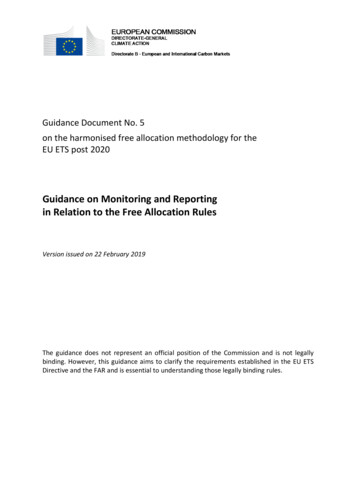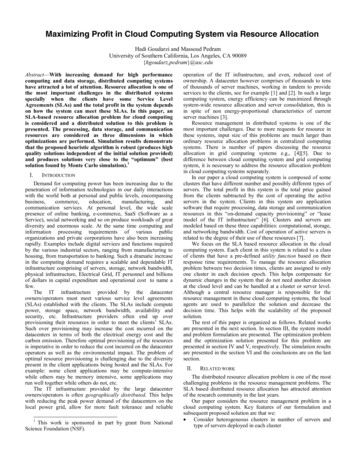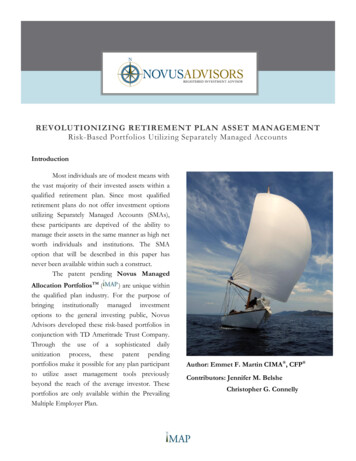
Transcription
ISSN (print):2182-7796, ISSN (online):2182 -7788, ISSN (cd-ro m):2182-780XAvailable online at www.sciencesphere.org/ijispmResource allocation in IT projects: using scheduleoptimizationMichael A. ChiltonKansas State UniversityManhattan, KS Resource allocation is the process of assigning resources to tasks throughout the life of a project. Despite sophisticatedsoftware packages devoted to keeping track of tasks, resources and resource assignments, it is often the case that projectmanagers find some resources over-allocated and therefore unable to complete the assigned work in the allotted amountof time. Most scheduling software has provisions for leveling resources, but the techniques for doing so simply addtime to the schedule and may cause delays in tasks that are critical to the project in meeting deadlines. This paperpresents a software application that ensures that resources are properly balanced at the beginning of the project andeliminates the situation in which resources become over-allocated. It can be used in a multi-project environment andreused throughout the project as tasks, resource assignments and availability, and the project scope change. Theapplication utilizes the bounded enumeration technique to formulate an optimal schedule for which both the tasksequence and resource availability are taken into account. It is run on a database server to reduce the running time andmake it a viable application for practitioners.Keywords:project management; optimization; resource allocation; bounded enumeration.DOI: 10.12821/ijispm020303Manuscript received: 9 April 2014Manuscript accepted: 15 July 2014Copyr ight 2014, SciKA. General per missio n t o republish in pr int or elect ronic forms, but not for profit , all or part of t his mat er ial is gran t ed, provided t hat t heInt ernat ional Jour nal o f I nfor mat io n S yst ems and Pro ject Manage ment copyr ight notice is given and t hat reference made t o t he publicat ion, t o it s dat e of issue, and t ot he fact t hat reprint ing pr ivileges were grant ed by per miss io n o f SciKA - Associat ion for Pro mot ion and D isseminat io n o f Scient ific Knowledge.International Journal of Information Systems and Project Management, Vol. 2, No. 3, 2014, 47-59 47
A catalog of information systems outsourcing risks1. IntroductionThis paper discusses allocation of renewable resources within Information Technology (IT) software developmentprojects. While the overall process of IT development is similar to managing projects in any other industry, it has somedistinct differences. First, IT projects rely almost exclusively on renewable human resources. As personnel are assignedtasks, they complete them in a particular sequence and pass the project on to the next person in the chain. Once freed,the worker then begins work on the next project. Second, IT projects are considered intellectual work in whichinformation about the project must be shared with co-workers, and so adding more workers to speed things up usuallydoes not help, but may make things worse [1]. Third, the direct costs of an IT project are almost exclusively due to laborcosts [2]. Some IT applications may require hardware and software acquisitions; however, these are generally notconsidered direct variable costs, because they are considered part of the firm’s IT infrastructure and can be reused forother projects. Additional characteristics of IT projects include project environments in which multiple projects areconcurrently active and that many projects are given pre-planned deadlines (i.e., they are time boxed). Time boxingcauses project managers to carefully evaluate the project scope in order to meet pre-planned deadlines, while the natureof the work and prior experience may fix the number of personnel assigned to any particular task.These factors form the basis of this analysis of IT project scheduling and resource allocation methods in this paper. Wetherefore focus on fixed sets of human resources with different skill sets forming separate labor pools who areattempting to complete a project in the minimum amount of time (minimized make span). Our analysis includesmultiple projects that may be competing for the same sets of human resources.The first step in creating a work plan for a new IT project is to identify and schedule the set of tasks necessary tocomplete the project. The resulting schedule must observe all of the technical constraints imposed by the project (i.e.,the sequence of tasks) and the applied constraints imposed by the number of available resources. In the planning stages,project schedulers often estimate task duration based on the number of resources available and therefore over allocationof resources for a single project is not expected. Once the project gets underway, however, resources can easily becomeover-allocated due to a number of different factors, such as changes in personnel, lack of availability of personnel due tovacations, sick leaves or changes of employment or because a number of projects may be competing for the same set ofresources. The result is that resources assigned to certain tasks may not be able to complete them within the plannedschedule and this situation calls for immediate action on the part of the project manager. To be competitive, anorganization must attempt to schedule all tasks so that the project is completed in the minimum time.Scheduling IT projects proceeds as just described and includes identifying tasks, estimating their duration and placingthem on a timeline (Gantt chart) that visually displays their sequence, duration, and start and end date. Resources arethen assigned to each task from available labor pools, which are separated by skill set. IT projects resemble assemblylines in that different pools of resources perform tasks at specific times during the project. That is, business analystsgenerally are assigned to the project near the beginning and they build a business case for the application. Next, thesystems analysts begin to gather requirements and formulate models of how the software will work. This goes into thedesign specifications that are passed to programmers who implement the application. The completed application is thensent to quality engineers who provide alpha testing to clear up any bugs and ensure that the application meets the users’requirements. This may be followed by beta testing with a sample of users not involved in the application’sdevelopment to further refine the program and identify bugs. Once any identified bugs are removed, the completedapplication is sent to those who are responsible for its deployment and training of users. The duration of the taskscontained in each of these stages is dependent upon what must be done, the complexity of the tasks and the number ofresources available at the time. While this may seem like a straightforward process, problems with the planned schedulecan occur when multiple projects are being executed at the same time. Problems can also occur when changes are madeto the project itself or to the labor pool to which a set of tasks is assigned. Any of these situations can cause delays,which can in turn affect the cost of one or several projects.Delays can also be caused by the over-allocation of resources. Delays in one project may affect other projects that arebeing executed concurrently, causing a slowdown in production and fewer projects meeting their deadlines. WhenInternational Journal of Information Systems and Project Management, Vol. 2, No. 3, 2014, 47-59 48
A catalog of information systems outsourcing risksresources become over-allocated, the project managers must devote time to reallocating tasks to additional personnel orto different time periods. Although this can sometimes be done automatically in sophisticated project managementsoftware, the process is not particularly straightforward, it consumes a lot of time and the result is usually less thansatisfactory. A solution to this problem is to schedule the tasks in all active projects while taking into account themaximum number of resources available. Doing so would prevent over-allocating any resource. We take this approachin this study by introducing a software application that takes the production schedule as input and produces an optimalschedule as output. The software is programmed to recognize the restrictions imposed by the sequence of tasks and bythe number of resources from one of several resource pools. Because of this, the resulting schedule yields no overallocated resources. The application can be used in a multi-project environment and can be run throughout the lifetimeof any project, thus providing more current estimates to the project manager.We have found that over-allocation of resources is a common problem within firms engaged in IT development. In fact,this study was prompted by representatives from a large petro-chemical company who were having difficulty withresource allocation. Project managers in the company often found that they had IT developers who were often overscheduled even though a sophisticated commercial project management program was used to plan, assign and trackactivities in a large number of concurrent projects. The company asked us to assist them with solving the problem, andso we turned our attention to creating the program that we introduce in this paper.This paper is organized as follows. The first section is devoted to a detailed explanation of the over-allocation problemand a survey of the literature relevant to it. The next section discusses the software artifact that we produced, includingthe logic upon which it is based and the results of testing it against a number of artificially generated project networks.The last section outlines the remaining work to be done and provides a description of the experimental design, thevariables to be measured, the metrics to be used and the definitions of what would be considered successful findings.2. Overview and literature reviewScheduling tasks in a project is a complex and time consuming endeavor and has been studied and improved since theCritical Path Method (CPM) and Program Evaluation and Review Technique (PERT) methods were introduced in the1950s. CPM is known to suffer from its inability to deal with the problem of limited resources [3]. PERT was designedto take into account some of the uncertainty in estimating the duration of tasks that comprise a project [4], by includinga set durations for each task based on an optimistic, expected or pessimistic estimate and computing a weighted averageto act as the best estimate. CPM and PERT are applied to one project at a time and neither specifically address therestrictions imposed by limited resources [5]. It is doubtful that they were ever intended to be used in a multi-projectenvironment in which different but concurrent projects would compete for the same set of resources.While the original project management techniques were designed to help better manage large and complex projects, itquickly became apparent that improvements were needed in order to help reduce costs and shorten the time tocompletion. In addition, because resources are limited in any project endeavor, this constraint needed to be added to thetechnique. A significant amount of research was accomplished in the ensuing decades, devoted to minimizing theduration of the project and accounting for the limitations imposed by limited resources. Wiest [6] pointed out thatalthough the critical path may represent the longest sequence of tasks in a project, the idea of it being critical becomesmeaningless when resources are limited, because any task may be delayed due to the lack of resources. He identified acritical sequence to account for both the required sequencing of tasks and the constraint of limited resources, but warnedthat the linear programming techniques (at the time) were infeasible for practically sized projects due to theircomputational requirements. Computational efficiency was analyzed and reported by Davis [7], who discussed theproblems encountered when attempting a mathematical formulation of the resource constrained scheduling problem.Herreoelen, De Reyck and Demeulemeester [8], followed in this vein by discussing the computational efficiency ofseveral optimization techniques developed since Davis’ [7] analysis.Gutjahr and Nemhauser [9] also addressed the computational difficulty of the class of scheduling problems by statingthat because of the large number of possible solutions, a complete enumeration of them is impractical. They presented aInternational Journal of Information Systems and Project Management, Vol. 2, No. 3, 2014, 47-59 49
A catalog of information systems outsourcing risksmore efficient technique that eliminates some solutions during the computation because they violate one or more of theconstraints imposed. An exact solution can then be determined much more quickly and efficiently than othertechniques. Their method was applied to the resource constrained scheduling problem by Davis and Heidorn [10],which we discuss later.The difficulty of the scheduling problem seems to have challenged researchers into searching for solutions. Forexample, Moodie and Manville [11] presented an integer linear programming (ILP) technique aimed at solving theassembly line balancing problem, which is similar to finding an optimal schedule for a project. Held and Karp [12]presented a dynamic programming solution to scheduling problems and demonstrate the technique by applying it toboth the traveling salesman and the line balancing problems. Dynamic programming has been applied to this problemby numerous researchers since then [cf. e.g., 13, 14]. Goldratt [15] introduced his theory of constraints and the criticalchain as a way of viewing, managing and scheduling projects.Robinson [16] published an algorithm that determines the cost-time function in order to find the project’s minimumduration resulting from the optimal allocation of resources to each activity. Implicit in his study is that the number ofresources can be adjusted to shorten the duration of any particular task. In software development we find this generallynot to be the case because an organization assigns resources (from limited resource pools) to tasks based on the need forspecific skills to accomplish the task and because adding more resources to a project tends to slow it down [1]. Addingresources to shorten a project may work well when the work does not involve creative activity or communicationamong workers; however, in software development, adding more workers is, in Brooks’ words, “Like dousing a firewith gasoline ” [1, p. 14].When limited resources are taken into account the problem is labeled as the Resource Constrained Project SchedulingProblem (RCPSP). This type of scheduling problem is known to be NP hard [17], because the solution space growsmuch faster than the problem space. It can therefore quickly become intractable for practically sized projects due to theamount of computation required, which is manifested as computing time. Much work has been devoted to this problem,which has generally been addressed either through heuristics or exact solutions [18] and aimed at scheduling around thelimitations imposed by scarce resources. Heuristic solutions tend to be favored because they are fast and providereasonable results, while exact solutions, such as linear and dynamic programming techniques require too much time forpractically sized problems. Davis and Patterson [19] compared the results of eight widely used heuristics to an optimumsolution produced through the bounded enumeration technique found in [10]. Their results showed a wide variance inthe ability of each of the 8 heuristic techniques to produce schedules that were close to optimal, with the averagepercentage increase above optimal ranging from 5.6% to 16%. Of the 83 test projects used in the analysis, the ability ofheuristics to find an optimal schedule also varied widely and ranged from 1 to 24 test cases [19].Recent work focusing on heuristics has employed such techniques as genetic algorithms and artificial intelligence [cf.e.g., 20] and hybrid techniques [21]. Studies have also analyzed multi-mode problems [22] and have applied metaheuristics to the multi-mode problem [23]. Additional work has been done recently on exact approaches as well,including mixed integer programming [24] and dynamic programming [25].Bandelloni and colleagues [26] provided a definitional distinction between resource allocation and resource leveling.They said that resource allocation applies to the case when resources are limited and the scheduling objective is to“keep the project completion time as close as possible to the critical path length such that the resource constraints aremet” [26, p. 162]. They further classified resource leveling as a process in which there are no resource limits and theconsumption of resources can be controlled to follow a desirable shape. The focus of this study will be on the allocationof resources in a software development project with the goal of scheduling resources to perform specific tasks andensuring that they are not over-allocated, that is, they are not scheduled to perform so many tasks that they cannotperform them in the time required.Despite the distinction provided by [26], we should note that the terms resource leveling and resource allocation areoften used interchangeably. For example, most project management software programs have options for “resourceleveling.” This function attempts to solve the allocation problem and can be invoked when the project managerInternational Journal of Information Systems and Project Management, Vol. 2, No. 3, 2014, 47-59 50
A catalog of information systems outsourcing risksdiscovers that a resource is over-allocated. In addition, [27] compared the resource allocation capabilities of sevencommercial project management programs, but his analysis seems to address a resource leveling function, because heasked the programs to optimally allocate resources while at the same time find the minimal makespan for a project,suggesting a causal link between the two. In any case, the problem we study here is intended to provide an optimalschedule in the planning phase that incorporates the resource limitations and by doing so, will encounter no overallocation problems throughout the life of the (unchanging) project. We will also discuss the effects of various types ofchanges on the project schedule.When a project manager is faced with an over-allocated resource, he can invoke the resource leveling option in hissoftware. Doing so generally causes one or both of two things to occur: some tasks are reassigned to others who areunder-allocated and/or some tasks are delayed until enough resources become available to complete the task(s) affectedby the over-allocation. How this is done by the software is not particularly straightforward and each package may useits own proprietary method to do so [27]. The results can be difficult to understand and even more difficult to manage,as it may require a larger time investment by the project manager into activities that are not a part of the project. It mayalso require that some tasks be split by interrupting work on one task to make resources available for others. It issometimes recommended that leveling of over-allocated resources be done individually and manually [28].Our stated goal in this paper is to introduce a software program that produces an optimal schedule that accounts for boththe technical and the resource constraints of a project in order to prevent over-allocation of resources. A scheduleproduced at the beginning of a project that conforms to this definition will have no over-allocated resources; however,the conditions under which software development projects are conducted may change and this may result in resourceallocation problems. There are three factors that may affect the allocation of resources during the life of a project. Thefirst is an increase in scope of the project that will necessitate more effort to complete it. This is not an uncommonoccurrence in software development, and has been listed as the 14th most often reason for IT project failure [29]. It hasalso been found to occur in 23% of all IT projects [29]. Secondly, resources may become unavailable during periods inwhich they were originally thought to be available. This may occur for a variety of reasons (e.g., vacation, sickness, orthe loss of people to other jobs). Finally, several projects that compete for the same resources may be executedconcurrently. Managing multiple simultaneous or overlapping projects can increase the level of difficulty enormouslyover the single project case, because management must attempt to balance the resources [30]. This can adversely affectcompetitiveness since a bidding process must take into account those resources already committed when preparing a bidon a new project, which may be executed concurrently with others.There have been numerous heuristics developed and used because of the low computational expense, and several exactsolutions exist but are not often used in practice for the opposite reason. One exact method that shows promise and isused here, is the bounded enumeration method of [10]. This method takes a set of fixed-duration tasks, which must becompleted in a specific sequence and which require a fixed number of resources from one or more resource pools. Thefirst step in the algorithm is to divide them into unit duration tasks. Thus, if the unit duration was one day, a five daytask would be divided into 5 one-day tasks. The schedule can then be displayed in a network diagram or as a Ganttchart, either of which makes the technical sequence easy to see. The diagram or chart can be annotated with the numberof resources needed for each task from each resource pool. Each resource pool is assumed to contain a maximumnumber of resources that cannot be exceeded.The method used in [10] begins evaluating the sequence of activities by entering the first task into the algorithm anddetermining those sets of tasks that could follow based upon the restriction imposed by the technical sequence. Theseare termed feasible subsets, but they do not include resource constraints. This process continues so that a set of feasiblesubsets is created for each stage in the project. The number of stages initially equals the length of the critical path, butmay be extended as the program processes the inputs. The next step is to eliminate from consideration any feasiblesubset that cannot meet the resource constraints. This leaves a set of paths through the project network that will meet alltechnical and resource constraints. The final step is to determine which path is the shortest, i.e., has the least number oftime periods (steps) and therefore conforms to the definition of minimum make span.International Journal of Information Systems and Project Management, Vol. 2, No. 3, 2014, 47-59 51
A catalog of information systems outsourcing risks3. The software artifactWe created a software application that employs the bounded enumeration technique just described. Its performance isexceptionally fast because it makes use of the speed and power of a database server to reduce the computing timerequired. To be useful to practitioners, it must be able to find a solution in a reasonable and practical amount of time.We now provide the details of its implementation and in the next section provide a tabulation of the results of itsperformance.A predetermined schedule is used as input. This schedule can be taken from a network diagram and it must include therequired sequence of activities (the technical constraint), the duration of each task and the number of resources requiredfor each task from each resource pool. A production schedule produced in a commercially available projectmanagement software program (e.g., Microsoft Project, Primavera, or SAP’s PS module) or a custom schedulingprogram can provide this input. This data must be treated by an interface, which converts it into a format that can bestored within a relational database. The database consists of 6 separate but related tables. As part of the processing, theactual ask descriptions in the production schedule are replaced with a 5 character code before being entered into themain task table. The entity relationship diagram for the database is shown in Fig. 1.Fig. 1. Relational SchemaThe Task table holds data relating to each task in the project and is related to the Predecessor table, which identifies thepredecessor of each task. A simple SQL query of these two tables will yield the technical sequence of the project.Resources are recorded in the Resource table by name and are assigned to a specific labor pool. Because the details ofeach pool are recorded in a separate table (the Resource Pool table), there is no limit to the number of pools that can beincluded. This can be particularly advantageous because it can be used to separate beginning workers from those withmuch greater experience and therefore provide a better assessment of the duration of a task. Although both start and enddates are recorded in the Task table, these entries are generally not used in the program because these dates will bedetermined after the program runs. There are two exceptions. First, the initial start date for the first task is used as areference from which all other dates can be calculated using the task durations. Second, any tasks that have beencompleted can be eliminated from the algorithm and a new reference start date can be used. This allows the program tobe run in the middle of a project and ignore those tasks that have been completed and will no longer affect its outcome.There are several temporary tables used to store the data as it is processed by the program that are not shown in Fig. 1.They are described below and are depicted in Fig. 2. The purpose of these tables is to hold data that is obtained byjoining the related tables to produce a single storage area for each process used in the program. As each process in thealgorithm is executed, the resulting data is reformatted and moved into a new table. While the structure of these tables ispermanent, the data contained within them is transient, meaning that it is kept only for the life of the project. As projectsInternational Journal of Information Systems and Project Management, Vol. 2, No. 3, 2014, 47-59 52
A catalog of information systems outsourcing risksare executed and completed, tasks which have been completed are removed; as new projects are added, their tasks arethen stored in the tables. The data from old projects can then be archived for future analysis or simply deleted.Production data is pre-processed by an interface, which accepts the production schedule as input, encodes the tasknames as 5 character codes, separates each task into single time-unit tasks and formats it for entry into the six tables inthe database. This process is shown in figure 2 as part of the interface. Once formatted, the database server then queriesthe data within these six tables and processes it as described below. The result is an optimal schedule that can bereturned to the production system via an interface that will re-format the output as needed for the production system.Obtaining the optimal schedule is performed as follows:1) Create a matrix of tasks, their predecessors, duration and the number of resources required for each task from anynumber of resource pools. This matrix is stored in the first temporary table. This process is very quick. For a 25 taskproject, it usually takes about 30 to 60 seconds (see table 1).2) Query the first temporary table and create a list of the project tasks in the order they must be performed (the technicalsequence) and store the result in the second temporary table. This list will show a set of tasks that can be performed inone period and all of the tasks that could possibly follow these tasks (called feasible subsets) in the next period in eachrow of the table. In addition to recording these sets of tasks, the program also records the sum of the resources requiredto perform them from each resource pool. This table can grow to be quite large even for small projects. As an example,for a project with 25 independent tasks, we found that the program had created over 22,000 entries in this table.3) Query the second table and create an adjacency matrix (“A” network) and store the results in a third temporary table.This table stores sets of tasks that are compatible, that is, one set can follow another based upon the technical sequenceand the resource limitations imposed by each pool. Thus, many of the subsets from the second table are eliminated andthis table is generally much smaller. We have found that this process consumes the most amount of time. For the 25 tasksample project mentioned previously, the program ran in about 13 to 15 minutes (see table 1).4) Analyze the third temporary table to determine the optimal path. The optimal path is defined as the one with thefewest number of steps to completion; however, the program also analyzes the cost of each step by summing thenumber of resources multiplied by number of activities required for each activity within the step. The optimal path isstored in the fourth temporary table, but is not easily interpreted because it accumulates activities as the projectprogresses. This process ran much quicker than predicted, which was usually less than 10 seconds (see table 1).The result obtained in step 4) above is sent back to the interface for further processing before it can either be viewed bythe project manager and/or returned to the production system to update the production schedule. Ideally, the PM willview this output and determine its suitability before updat
Scheduling tasks in a project is a complex and time consuming endeavor and has been studied and improved since the Critical Path Method (CPM) and Program Evaluation and Review Technique (PERT) methods were introduced in the 1950s. CPM is known to suffer from its inability to deal with the problem of limited resources [3]. PERT was designed

![[Title to come] DSP Dynamic Asset Allocation Fund](/img/24/dsp-dynamic-asset-allocation-fund.jpg)









